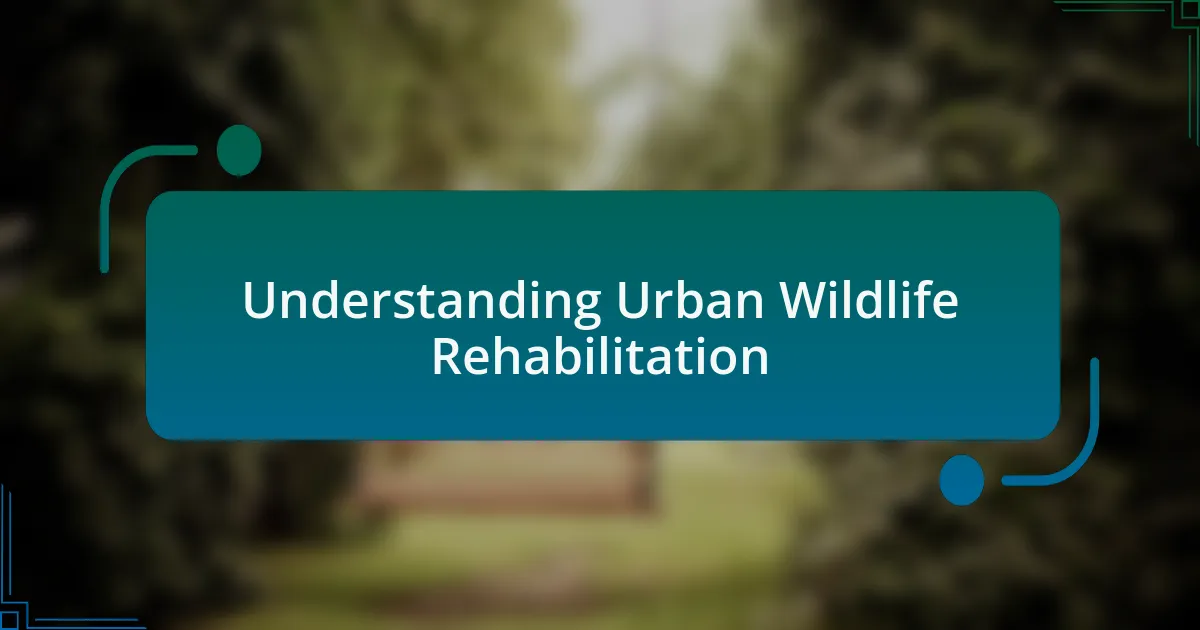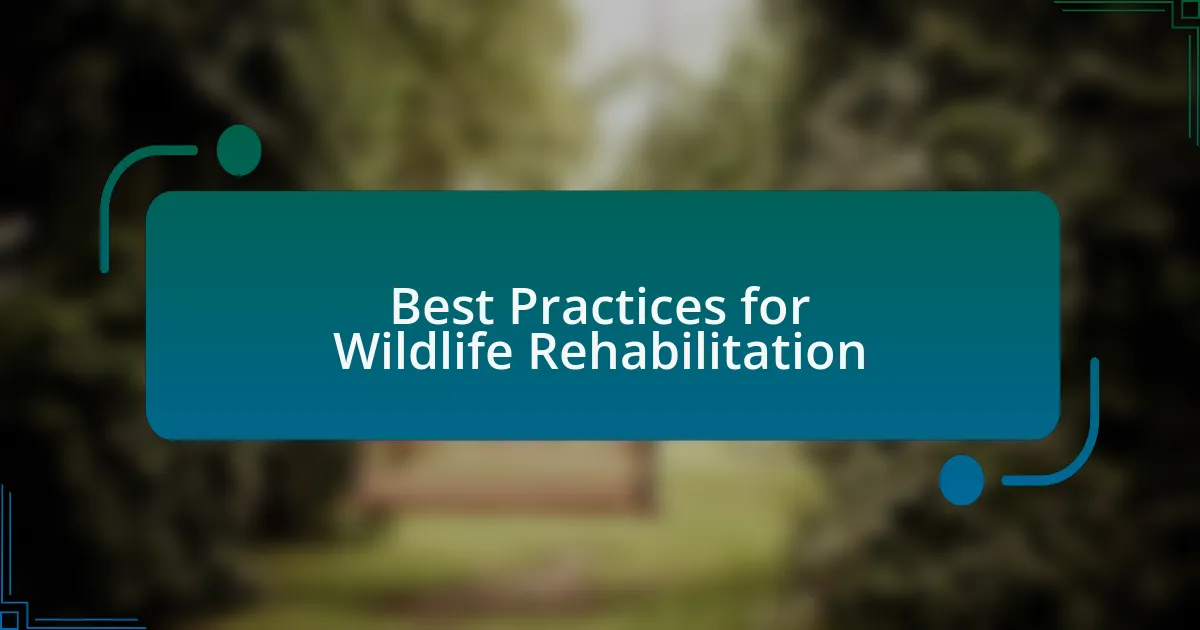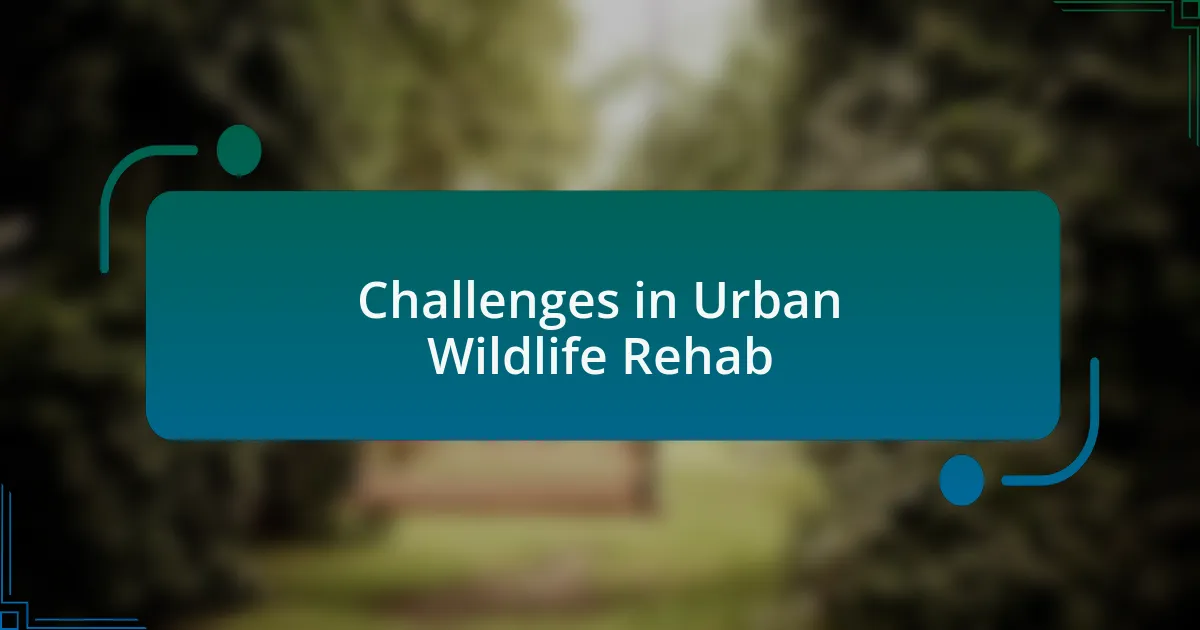Key takeaways:
- Urban wildlife rehabilitation requires immediate care and awareness due to habitat loss and other urban challenges.
- Environmental education fosters community responsibility and encourages proactive wildlife care among residents.
- Creating a stress-free environment and careful assessment are critical for successful rehabilitation practices.
- Community involvement enhances wildlife care, with partnerships and education playing key roles in fostering a compassionate approach to urban wildlife.

Understanding Urban Wildlife Rehabilitation
Urban wildlife rehabilitation is a fascinating intersection of nature and community. I still remember the first time I rescued a fledgling bird from my backyard. It was a tiny sparrow, vulnerable and trembling. That experience made me realize just how important it is to provide immediate care and attention to wildlife in our bustling cities. What would have happened to that little bird without intervention?
In my interactions with various rehabilitation centers, I’ve seen firsthand the effort required to address the unique challenges urban wildlife faces. From habitat loss to vehicle collisions, every encounter tells a story of resilience and struggle. I often wonder how many animals we pass by daily—each one a testament to the adaptability of life amidst concrete and noise.
Acquiring knowledge about local wildlife is critical for anyone involved in rehabilitation. For me, learning to identify different species and understanding their behaviors has been both enlightening and humbling. Have you ever witnessed a raccoon rummaging through trash late at night? It’s a reminder that these animals are simply trying to survive in an environment that often feels hostile. Engaging with these creatures can awaken a deep sense of responsibility in us all.

Importance of Environmental Education
Environmental education plays a crucial role in fostering a deep sense of respect and responsibility toward our surroundings. I vividly recall a workshop where we learned about the impact of littering on local wildlife. Seeing a documentary that illustrated how plastic waste affects marine life struck a chord with me. It was a moment of realization—each piece of trash can lead to devastating consequences for creatures that depend on clean habitats.
Understanding the ecosystem’s interconnectedness is vital in urban wildlife rehabilitation. One day, while out on a field observation, I noticed the relationship between the health of local plants and the thriving bird populations. It made me reflect: what would our cities look like if everyone understood that preserving green spaces is not just an aesthetic choice but essential for wildlife? This understanding cultivates a community that values environmental stewardship.
The emotional connection we develop through education also inspires action. I remember the first time I volunteered at a wildlife recovery center. Hearing the stories of rehabilitation for injured animals made me appreciate the fragility of life more than ever. Can you recall a moment when you felt compelled to take action for the greater good? Those moments are often sparked by a profound understanding of the world we inhabit.

Best Practices for Wildlife Rehabilitation
One of the most effective best practices in wildlife rehabilitation is immediate assessment and intervention. I remember a day when I found a small bird that had collided with a window. Instead of rushing to treat it, I took a moment to observe its behavior and breathing. This allowed me to gauge the extent of its injuries, highlighting how careful assessment is essential before any action. Have you considered how crucial that first step is in ensuring the right care for injured animals? It’s not just about the act itself, but understanding their needs first.
Creating a stress-free environment is another key aspect of rehabilitation. I recall my experience with a raccoon that was brought in after being trapped. Providing a quiet, dark space with minimal human interaction made a world of difference in its recovery. It’s fascinating how animals, much like us, require a sense of safety to heal. Have you ever noticed how being in a calm environment helps you focus and recover from fatigue? For wildlife, this is just as important.
Lastly, maintaining a network of support among rehabilitation professionals can significantly enhance the quality of care provided. I often share experiences with fellow rehabilitators over coffee, exchanging tips and learning from each other’s successes and challenges. This collaboration not only strengthens our practices but fosters a sense of community that uplifts everyone involved. Have you thought about how sharing knowledge can exponentially improve outcomes for our urban wildlife? Sometimes, the best ideas emerge from discussions with passionate individuals who share the same goals.

Community Involvement in Wildlife Care
When it comes to community involvement in wildlife care, I’ve found it truly inspiring to witness neighbors come together for a common cause. Last summer, a group of local residents organized a cleaning day at a nearby park, and we discovered a nest of baby squirrels tangled in litter. Instead of just walking by, everyone jumped in—clearing debris and discussing ways to foster a better environment for local wildlife. It’s incredible what a motivated community can achieve when they unite for the well-being of our natural neighbors.
Engaging the community goes beyond just cleanup efforts; it also includes education and awareness. I remember hosting a workshop on urban wildlife, where families brought their children to learn how to coexist with the critters in our backyards. As I watched the kids’ eyes light up when they identified animals like owls and foxes, I realized how crucial it is to inspire the next generation to care about wildlife. Have you considered the long-term impact of sharing knowledge with young minds? It plants seeds of compassion and responsibility that can grow into lifelong commitments to wildlife care.
Moreover, forming partnerships with local businesses can provide invaluable resources for wildlife rehabilitation. One memorable collaboration was with a pet supply store that hosted a donation drive for wounded animals. Their support increased our outreach to the public and provided essential supplies we desperately needed. Isn’t it fascinating how creative partnerships can enhance wildlife care initiatives? It not only brings in much-needed supplies but also connects more people to the cause, making each effort a collective achievement.

Challenges in Urban Wildlife Rehab
Urban wildlife rehabilitation presents a unique set of challenges that often catch us off guard. I vividly recall a time when I received a call about an injured pigeon in a busy urban area. The noise of traffic and the hustle of daily life made it incredibly difficult to assess the bird’s condition without causing further stress. How do we protect these vulnerable animals in such chaotic surroundings? It takes patience and creativity to navigate these moments effectively.
Another significant hurdle is dealing with limited resources in urban settings. I remember a situation where I had to prioritize which injured animals received care based on available funding and supplies. The heart-wrenching reality is that, unlike rural rehabilitators, we often face financial constraints, making it harder to help every animal in need. Have you ever felt the weight of having to make tough choices that affect lives? It’s an emotional burden that lingers long after the decision has been made.
Finally, there’s the constant struggle to balance public awareness with the safety of wildlife. One experience that stands out is when I worked to educate the community about the dangers of feeding wild animals. While many people had the best intentions, their kindness could end up causing more harm than good. Isn’t it fascinating how a small misunderstanding can ripple through an entire ecosystem? It stresses the importance of clear communication and shared understanding among urban residents to ensure every wildlife rehab effort is both compassionate and effective.